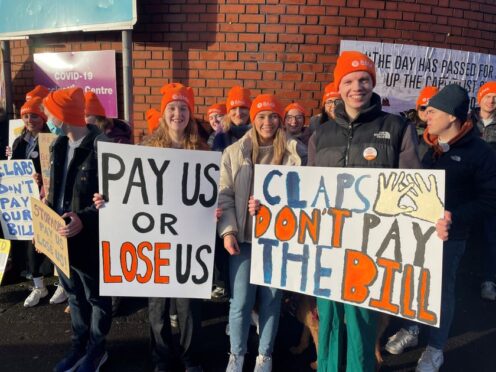
Junior doctors in England have voted by a huge margin to continue taking industrial action for the next six months in their long-running pay dispute.
The British Medical Association (BMA) urged the Health Secretary to make a new offer after announcing that its members backed more action by 98%.
A total of 33,869 of junior doctors voted in favour on a turnout of 62%, with the new mandate lasting until September 19.
The ballot also approved the use of action short of strikes.

The BMA’s Junior Doctors Committee co-chairs Dr Robert Laurenson and Dr Vivek Trivedi said: “It has now been a year since we began strike action. That is a year of strikes too many.
“The Government believed it could ignore, delay, and offer excuses long enough that we would simply give up. That attitude has now led to the NHS wasting £3 billion covering the strikes.
“This is more than double the cost of settling our whole claim, and as we see in the results of today’s ballot, delaying tactics will not work. Doctors are still determined to see their pay cuts reversed, and they are willing to keep striking another six months to achieve that.
“The Government should see the urgency of the situation. Rather than waste time dragging out talks, they can come forward with a credible offer on pay right now.
“They don’t need to be in the same situation six months from now, with even more taxpayer money wasted. Instead they could be celebrating a revitalised and reinvigorated junior doctor workforce, one that feels that their value has started to be restored.
“That would be an achievement worth celebrating for everyone and begin to finally turn the tide on the deteriorating workforce crisis.
“No doctor wants to be on strike for a second longer than they have to, but it took us 15 years of declining pay to get here. Today’s re-ballot shows that doctors understand that reversing this means being in the struggle for the long haul.
“We ask the Health Secretary to come forward as soon as possible with a new offer – and make sure not a single further strike day need be called.”
"With this renewed mandate, we retain our leverage. And we will use it precisely when we need to."@RobLaurensonD4P and @_VivekTrivedi thank members for voting Yes in the junior doctor re-ballot in England.
Watch 📺: pic.twitter.com/ZnzjGJhRBk
— Junior Doctors (@BMA_JuniorDocs) March 20, 2024
The deputy chief executive of NHS Providers, Saffron Cordery, said: “Today’s announcement marks another worrying escalation in this lengthy dispute between the Government and junior doctors.
“The resounding backing for six more months of strike action as well as action short of strikes – which is just as hard to plan for and manage – will inevitably lead to more disruption to patient care.
“The knock-on effects for trusts will be also be major worry for trust leaders and their teams who have spent countless hours preparing for strikes, including cancelling and rescheduling appointments while doing everything they can to protect patient safety. This is time that could have been spent improving patient care and tackling sky-high waiting lists.
“With today’s results underlining the sheer strength of feeling among junior doctors, trust leaders are now facing anxious waits on three fronts with consultants voting on whether to accept their new deal, and specialist, associate specialist and specialty doctors being surveyed on their rejected deal.
“Alongside the nearly 1.5 million appointments delayed since industrial action began, strikes are expected to cost the NHS an estimated £3 billion. We cannot go on like this. Politicians and unions must urgently find a way to resolve all disputes for the sake of patients, staff and the NHS.”
Junior doctors have staged a series of walkouts over the past year as part of a campaign by the BMA for their pay to be restored after years of below-inflation increases.
A Department of Health and Social Care spokesperson said: “It is disappointing that BMA members have once again voted for industrial action, when we have already given junior doctors a pay rise of up to 10.3% this financial year and made clear in previous negotiations that further investment was available.
“Overall NHS waiting lists have decreased for four months in a row, but further strikes will impede this progress, and more than 1.4 million appointments and operations have now been rescheduled since industrial action began.
“We again urge the BMA Junior Doctors’ Committee to demonstrate they have reasonable expectations so we can come back to the negotiating table to find a fair deal that works for the NHS, doctors and patients.”

Enjoy the convenience of having The Sunday Post delivered as a digital ePaper straight to your smartphone, tablet or computer.
Subscribe for only £5.49 a month and enjoy all the benefits of the printed paper as a digital replica.
Subscribe